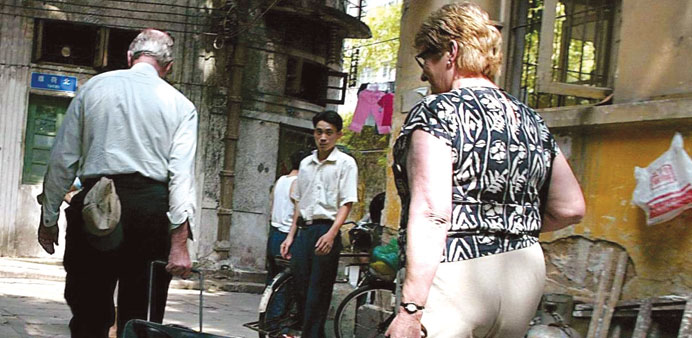|
At some point in the 1990s the sound of travel began to change. Previous changes had come about with celebrated inventions: when the hissing steam engine replaced the groaning cartwheel (or the flapping sail); when the puttering petrol engine saw off the neighing horse, and the screaming jet dislodged the whirring propeller. |
But this new change was both more demotic and more universal. It could be heard everywhere – in every humble lane and alley as well as the places where travellers usually gather: railway stations, hotel foyers and airports.
I can hear it in the street outside our house at most times of the day and night, but perhaps especially in the early morning when people start out on their longer journeys. “Driddle driddle driddle, dud-dud, driddle driddle driddle, dud-dud” is the way a children’s impressionist might describe it.
Had we heard the sound 30 years ago, we might have imagined a roller skater who’d got up to practise at dawn. Now it could be anybody: a barrister towing her wig and legal papers, a family setting out with enough luggage for a fortnight in the Algarve.
Light or heavy, large or small, yet another suitcase is rattling across the pavement cracks on its way to the bus stop or the tube.
What was life like before luggage had wheels? Like many men of his generation, my father used to carry our cardboard suitcase on his left shoulder.
It was seamanlike and jaunty, as though a heavy case might weigh no more than a parrot, though it meant you always had to walk on his right to enjoy a conversation; before he could answer an unexpected greeting from the left, he had to make a slow, considered turn in that direction, like a blinkered horse.
I never managed the technique of shoulder portage, arguing to myself that as suitcases had handles they were there to be used, though the real reason may have been that I simply wasn’t strong enough. My father could carry luggage a long way.
Early one Sunday morning, when my brother was returning from home leave to the RAF, I remember that we walked him the two miles over the hill to the station, no other transport being available; my father with his son’s kitbag hoisted over his shoulder as though it was nothing more than the knapsack that the choir sang about in The Happy Wanderer, which was a top 10 hit at the time.
Other people preferred other techniques. Street photographs show that a child’s pram could be heaped with holiday suitcases while the more portable child was carried in his mother’s arms.
I suspect my parents thought of this behaviour as “common”, perhaps because that was how families escaping rent arrears sometimes moved house (“the moonlight flit”).
Of course, money was the answer to everything. If you had it in even modest amounts, you could summon taxis and porters or send your trunk on ahead by train – a convenience still available to Clyde coast holidaymakers in the 1960s and Oxford students until at least the 1970s.
It seems like something out of Waugh or Wodehouse, and yet I remember a school friend being told by his socially ambitious mother: “Give the porter a shilling and tell him to put you and your case on the North Berwick train.”
The no-wheels suitcase, you might argue, depended for its existence on the poorly-paid servant class, still to be found on Indian railway platforms as the red-shirted coolies who pile your luggage expertly on their heads and literally run away with it, alarming the inexperienced traveller with the prospect that he might never see it again.
But it seems that rather than labour costs, it was the long, flat distances of airports that introduced the wheel. More research is needed; in the history of everyday things, luggage has still to find the level of scholarship that Henry Petroski lavished on the pencil or Redcliffe Salaman devoted to the potato, and, as is the case with almost every invention, more than one person can plausibly claim the credit for it.
Wheeled contraptions that could be strapped to suitcases existed in the 1960s, but it was only in 1970 that Bernard D Sadow, the vice president of a Massachusetts luggage company, had what turned out to be a eureka moment.
Struggling with two heavy suitcases on his way home from a family holiday in the Caribbean, he noticed at customs how an airport worker could move a heavy piece of machinery on a wheeled pallet almost effortlessly.
According to an account in the New York Times by Joe Sharkley, published 40 years later, Sadow told his wife, “You know, that’s what we need for luggage”, and on his return to work took the casters from a wardrobe trunk and mounted them on a big suitcase, with a pulling strap attached at the front.
It worked – well, why wouldn’t it? – and two years later Sadow’s innovation was registered as US patent number 3,653,474: “Rolling Luggage”, with a statement that pointed to air travel as its inspiration. “Whereas formerly, luggage would be handled by porters and be loaded or unloaded at points convenient to the street, the large terminals of today … have increased the difficulty of baggage-handling (which) has become perhaps the biggest single difficulty encountered by an air passenger.”
Still, rolling luggage was slow to catch on. Sadow remembered in the New York Times that men in particular resisted the ease of wheeled suitcases – “it was a very macho thing” – and the fact is that his suitcase was rather clumsy, a four-wheeler that was towed in the horizontal position. Like Logie Baird’s television, it was soon overwhelmed by a superior technology, in this case the two-wheeler “Rollaboard” devised in 1987 by Robert Plath, a Northwest Airlines pilot and DIY hobbyist who sold his early models to fellow crew members.
Rollaboards had telescopic handles and rolled vertically, at a dapper tilt. The sight of cabin staff marching them through airports established Plath’s invention as the suitcase that professionals used. Far more women began to travel alone on business trips. The fate of the no-wheels suitcase was sealed.
This month I travelled across Europe with a four-wheeled version of the old Rollaboard, a version I’ve come late to because, in the macho world of old luggage, two wheels seemed sinful enough. However: two wheels good, four wheels even better.
We travelled to our destination in a roundabout and quite complicated way – 10 trains, two lake steamers, one metro, three hotels – and while I realise this hardly puts me on the same level as Patrick Leigh Fermor or Norman Lewis, it seemed an achievement never to need a taxi for any of these transfers. Public transport all the way.
We rolled easily between trains, boats and hotels; on a good, level surface the four-wheeler seemed to generate its own energy, and when the going got tougher – on what, for example, the Tour de France knows as the pave – it was simple to revert to two wheels and proceed at the tilt.
Perhaps rolling luggage hasn’t been an unalloyed good. It encourages people to take more than they need – more than they could ever have carried in the unwheeled age – in suitcases the size of sea trunks that block carriage vestibules and the aisles of buses.
But outside the cheap flight, no other modern development has made travel easier. We owe it to Sadow and Plath – and durable plastic wheels and feminism.



